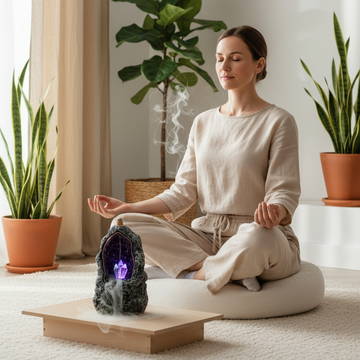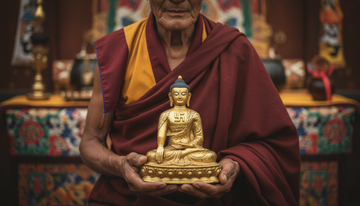Prologue: When the world is loud, how does the heart grow quiet?
On a weekday evening, packed in a subway car with a half-finished coffee, my phone kept buzzing while my mind pulled at a dozen tangled threads—work, family, expectation, regret. A teacher once said, “You think life is pushing you forward; in fact, you’re chasing your thoughts.”
As I walked closer to the Dharma, I found it wasn’t a distant term. It was a small lamp: it doesn’t replace your world; it teaches you to see it as it is. It doesn’t remove suffering; it teaches you not to be led by it.
I. What Dharma points to: seeing clearly, dependent arising, and the twin wings
Seeing things as they are: not as I prefer or fear, but as they present themselves.
Dependent arising: everything arises and fades within conditions. There is no isolated “single cause,” so we don’t need to blame or glorify one person—ourselves included.
Compassion and wisdom: two wings of the same bird. Wisdom recognizes “this is just a thought arising, staying, passing.” Compassion chooses kindness and responsibility after seeing clearly.
In one line: the essence of Dharma is to see clearly within conditions, and to respond with wisdom (non-clinging) and compassion (non-abandoning).
II. Why Dharma belongs in daily life
Stress: storms are configurations of conditions; I am not the storm.
Relationships: before judging right or wrong, I ask what is being triggered in me.
Decisions: shift from “I want to win” to “what best fits all conditions right now.”
Success: less fixation on the single result or single path; more respect for process and causes.
III. Common misconceptions, clarified
“Dharma is an escape.” It’s the opposite: it asks us to face reality—especially the uncomfortable parts—honestly.
“Emptiness denies everything.” Emptiness means “non-self-existence.” Because things are conditioned, they can change; therefore, hope is reasonable.
“Compassion is weakness.” Compassion is not permissiveness. After seeing clearly, it still chooses to protect and uplift—this requires strength and boundaries.
“Practice is to pray for luck.” Dharma cares about conditions and results: invest energy in cultivating causes, not just demanding outcomes.
IV. My reflections: three moments quietly reshaped by Dharma
Moment 1: Anxiety
I used to push everything to the edge and kept working late. After learning basic breath counting, I made a tiny ritual: three deep breaths, marking softly, “in—knowing, out—knowing.” Anxiety turned out not to be a brick but a cloud. I wasn’t killing anxiety; I stopped running with it.
Moment 2: Anger
In a tense conversation, I almost said the worst thing. In the split second before I spoke, I noticed heat in my chest and tension in my throat. I told myself, “Emotion has arisen—see it.” I drank water, paused ten seconds, then voiced my needs. I didn’t become a person without anger; I became a person who sees first and responds later.
Moment 3: Disappointment
A project fell through, and I collapsed into “it’s all my fault.” With dependent arising in mind, I saw success as multi-causal. When I stopped placing the entire causal map on myself, energy returned; guilt subsided.
V. Bringing practice down to earth: view, meditation, conduct
View (Right View): give yourself a daily reminder to see clearly—what thought carried me away today? Where did it come from, and where was it going?
Meditation (Right Mindfulness/Concentration):
Walking meditation: slow down a little; count steps with breaths for 3–5 minutes.
Loving-kindness: silently offer, “May I be steady. May you be steady. May all beings be steady.”
Conduct (Right Speech/Action/Livelihood):
Speech: before speaking, check: Is it true? Is it helpful? Is now the time?
Action: do what is wholesome within your capacity—even a sincere apology.
Livelihood: let your work align, as far as possible, with conscience.
If you need a system, see the Noble Eightfold Path as a whole-life training that brings clarity and kindness into speech, action, livelihood, attention, and focus.
VI. Likely bottlenecks and gentle responses
“Too many thoughts.” Normal. Don’t fight them. Label “thinking—known,” then return to the breath.
“I feel more sensitive.” You’re noticing signals you used to ignore. Ground attention in contact points: feet, seat, hands.
“I see parts of myself I dislike.” Good news—that’s honesty. Speak to yourself kindly: “I am learning.”
“Progress rises and falls.” Treat practice like brushing your teeth—regularity beats intensity.
VII. A seven-day starter proposal
One intention each morning: “Today, I practice seeing as it is.”
Three-minute sits: morning and evening.
One loving-kindness round: for yourself, someone close, and someone difficult.
One right-speech pause: in the hottest moment, pause ten seconds.
One gratitude line: before bed, write a single thing that softened your heart today.
Epilogue: Not making the world quiet—learning to be quiet in its noise
The essence of Dharma is not in grand phrases but in every moment you’re willing to see honestly. It doesn’t promise “no wind, no rain.” It offers this: when winds rise, you learn to let them pass through you, rather than turn them into who you are.













